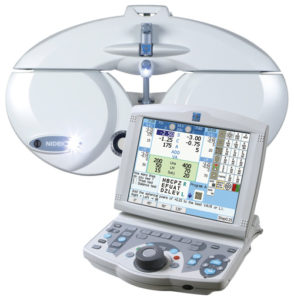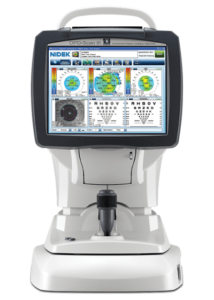

One of the first investments that Michelle McReynolds, OD, made when she opened cold was with the Marco OPD Scan III Wavefront Aberrometer and TRS automated refraction system. “I was looking for anything that would make my work faster because I didn’t have a technician when I first opened. It was just me doing everything,” she recalls. She opened West County Vision Center in St. Louis, Missouri, in 2011.
Being able to have a system that could streamline everything from keratometry and refraction and transfer the data to her Revolution electronic health records system made everything easier. “In fact, I’m still using the same TRS and OPD that I purchased then. I’ve not had any issues with that equipment,” she says.
However, she has expanded the usage of it. As she got busier and equipped a second exam lane, she installed a second TRS system. “Once you have it, it would be hard to go back to a manual phoropter,” she says. “I knew that if I didn’t add the TRS to the second exam room, I wouldn’t want to use that room.”
Being streamlined is just as important now as it was in the beginning. When she opened, her mother worked her front desk, and she had an optician. Now she has two full-time front staff, a technician and optician, and she is looking to expand. “We’re busier than we’ve ever been, and I’m booking two months out,” she says.
GOOD DATA FROM THE START


So she is grateful for the technology that helps her save time and provide excellent data on each patient. Patients interact with the Marco technology right at the start of their experience. In the pretest room, they sit at the OPD Scan III, which serves as a combination autorefractor, keratometer and topographer. “So many patients comment that they haven’t seen technology like this before,” she says.
Based on the data that Dr. McReynolds gains from the OPD, she can make decisions about the patient’s care plan. “I have detected a lot of early keratoconus, since we do a topography on every patient. The OPD obtains a topography automatically,” she says, noting that she can recommend crosslinking to help slow down the progression of keratoconus.
After those patients have been referred out for crosslinking treatment, she can fit them with scleral lenses if necessary.
“I also love that I can show patients their cataracts with the retro illumination image. I can point to the dark opacities on the image and explain that I might not be able to correct their vision to 20/20 due to the opacities in the cataract,” for example, she says.
REFRACTIONS MADE EASIER


As patients move into the exam room, they continue to be impressed by the technology she has brought in. “Patients make comments about how high-tech everything is. I love being able to say to patients at the end of the exam, ‘This is the prescription you had, and this is what I’m getting today.’ Showing them is so much better than me trying to explain what a half-diopter increase or decrease means.”
Toggling between the old and new prescription, patients can decide for themselves whether they want to purchase new eyewear. She can even use it to add validity to a complaint by a patient who says night driving is more challenging. The OPD will indicate if the patient needs a stronger prescription for night versus during the day. Dr. McReynolds says that she enjoys the refraction process. “Optometry was founded on doing refractions, and I get a lot of satisfaction knowing that I am getting the best possible results for my patients. Plus, patients feel the refraction is an extremely important part of the exam.”
Because she relies on the technology to support her findings, she can also use that time to talk with patients about other concerns or conditions. “I’m talking to them throughout the refraction and listening to how they respond,” she says.
iON BOOSTS EDUCATION
More recently, Dr. McReynolds added the iON imaging system from Marco and has found that it helps her with her rigid gas permeable (RGP) fits and patient education. She can capture video of the RGP lens on the eye and upload it to her specialty lens consultant. “That helps a lot,” she says.
For patients with foreign bodies or oil gland dysfunction, she has also found that the video image helps them understand their condition better. “If they can see what I am looking at, they are more motivated to follow my treatment recommendations. Patients tell me, ‘No one has ever explained that to me.’”
The value of that comprehensive exam and customized solution is as important to her today as it was on the day she first opened.
Read other stories in WO about ODs who use Marco technology here.



